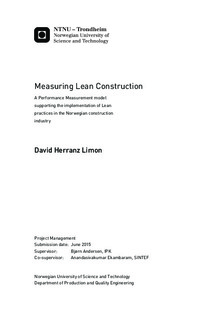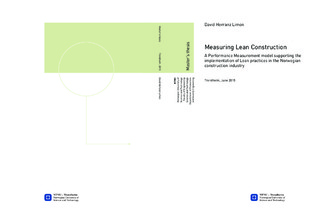| dc.description.abstract | The thesis examines the current performance improvement attempts in the construction industry and how their effects could be measured to sustain their implementation. The practices utilized in the industry under Lean Construction principles are the Last Planner, Pull Scheduling, Concurrent Engineering and Virtual Design Construction (VDC).
Construction companies in Norway have been implementing a number of practices intended for improving performance during the last decade. Although they have achieved relative success and perceived some benefits, companies find difficult to assess to what extent the benefits obtained are the consequence of implementing these practices. In addition, companies have recently shown interest in performance measurement systems as the way to know how is the actual performance of projects. The literature review shows a trend in the development of performance measurement towards industry- and purpose-specific frameworks. Other generic frameworks like the Balanced Scorecard, the EFQM Excellence Model, KPIs and Lean Six-Sigma have been reviewed during the study.
By using qualitative research the thesis aims to identify the practices implemented and measure their effects on project performance. It considers a stakeholder analysis perspective and the success factors in the implementation. The result is a performance measurement model supporting the implementation of Lean Construction. The model also establish the relationship between the practices used and the expected effects, and purposes an evaluation worksheet to facilitate the internal benchmarking of projects. The logic of these three elements together is described in the implementation roadmap.
The originality of the work is bringing together performance measurement and Lean Construction, the stakeholders perspective on the needs for the implementation of Lean practices and the explicit inclusion of external factors in the project evaluation. However, there are also some limitations about the data collection as the lack of measurement culture and project metrics being collected, and the interrelation among the effects observed, which could be studied in the future. Further research also include the further application of aggregation methods for the indicators included in the evaluation.
Keywords: Lean Construction, Performance Measurement, Effects, Project evaluation | |

